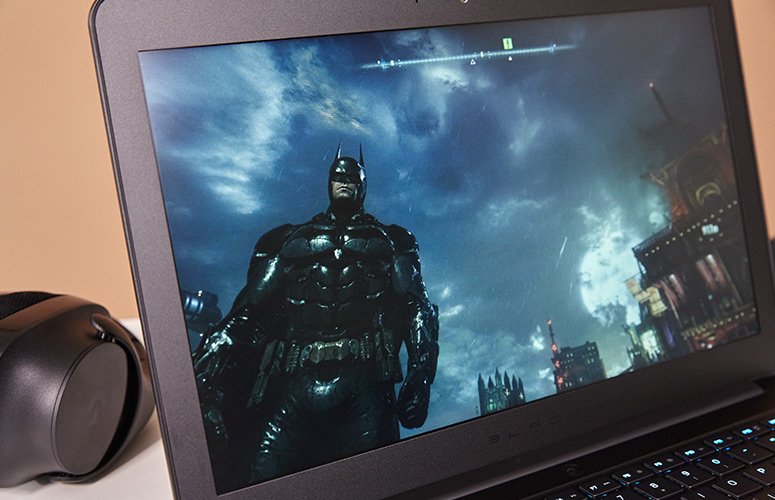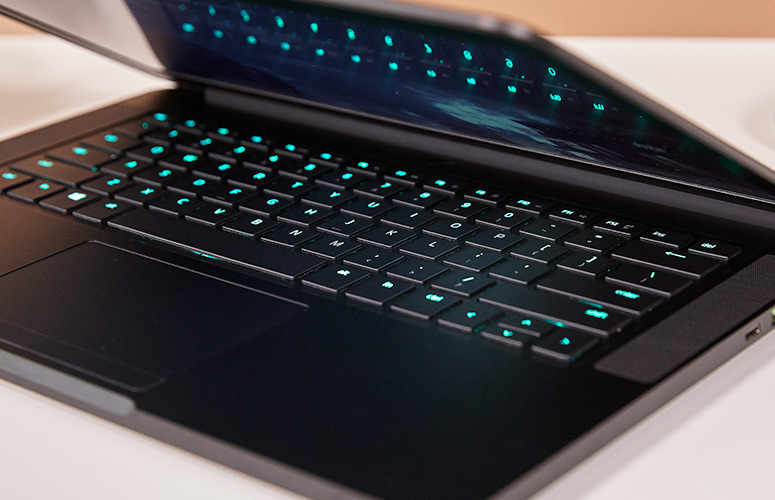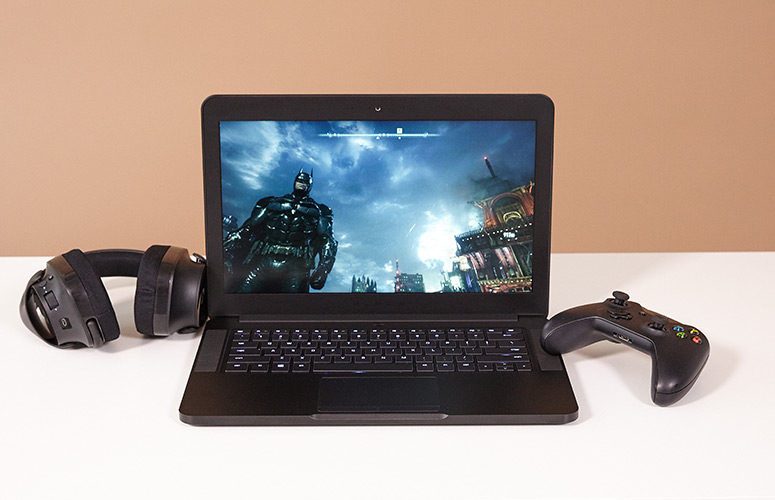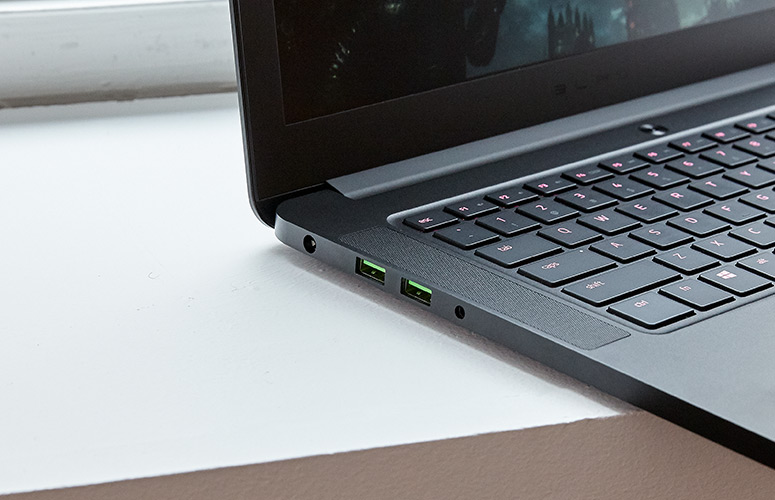Laptop Mag Verdict
The Razer Blade boasts VR-ready graphics a captivating Chroma keyboard and solid battery life in a devastatingly slim profile.
Pros
- +
Slim and attractive chassis
- +
Great graphics and overall performance
- +
VR-ready GPU
- +
Bright, vivid display
- +
Excellent battery life
Cons
- -
Runs hot when gaming
- -
Speakers could be louder
Why you can trust Laptop Mag
The Razer Blade (starting and reviewed at $1,899) just got another power-up. The laptop has made the jump to Kaby Lake, Intel's 7th-generation line of processors, which promise better performance and power efficiency. Pair that with a VR-ready Nvidia Pascal GPU; lovely display; beautiful keyboard and sleek, lightweight chassis; and you've got one of the slimmest gaming powerhouses on the market. Whether it's being used for work or play, the Blade is ready and able to get the job done.
Design
The Blade is just as striking as the original, and at 4.16 pounds and 13.6 x 9.3 x 0.7 inches, it's just as svelte. The Blade makes the smaller Alienware 13 (5.4 pounds, 13 x 10.6 x 0.87 inches) seem rotund by comparison, but is on a par with the MSI GS63VR Stealth Pro (4.2 pounds, 14.9 x 9.8 x 0.69 inches). It makes the Acer Predator 15 (8.2 pounds, 15.4 x 11.8 x 1.5 inches) look like a behemoth.
I could say that after four years, I've gotten tired of the Blade's sleek, inky-black aluminum exterior, but I'd be lying. The ethereal green trisnake logo has lost none of its enticing glow, beckoning me to run my hands over the lid, which is cool to the touch. The laptop's interior is outfitted in more obsidian-colored metal, accented by the backlit Chroma keyboard, which makes the multicolored keys look like fireworks against a jet-black sky.
The Blade's slim chassis doesn't allow for a plethora of ports, but what's here can support a formidable gaming battlestation. Along the right of the notebook, you'll find a USB 3.0 port, a Kensington lock slot and a full-HDMI port. In anticipation of the company's new graphics amplifier -- the Razer Core -- the Blade houses a Thunderbolt 3 port. When you're not using the amp, you can use the port to hook up a 4K display. On the left, there are a pair of USB 3.0 ports and jacks for the headset and power cord.
MORE: The Best Laptops for Every Need
Display
Sign up to receive The Snapshot, a free special dispatch from Laptop Mag, in your inbox.
Matte doesn't mean lackluster -- the Blade's 1920 x 1080 display is undeniable proof. My eyes delighted in the aquamarine sea offset by the bone-white cliffs in the 1080p "Wonder Woman" trailer. Details were so clear that I could see the delicate seams of Diana's famous gauntlets and the thousands of yellow and white sparks created by a bullet bouncing off it.
The Witcher 3: Wild Hunt was just as captivating, delivering a banquet of gold, rose pinks and tangerine with the rising sun. As he rode through a particularly dense forest, the resulting rays shone through, accenting the titular hero's chain mail and ashen-white locks.
The Blade's screen reproduced an excellent 115 percent on the sRGB color gamut on our tests. It easily surpassed the thin-and-light 90 percent average as well as the Predator 15 (110 percent) and MSI Stealth Pro (111 percent). However, the Alienware 13 and its amazing OLED panel was the clear winner at 210 percent.
When tested for color accuracy, the Blade's screen produced 1.5 on the Delta-E test (0 is ideal). That's much more accurate than the Alienware 13's 4.49, and it's only slightly better than the 2.1 category average and the Stealth Pro's 1.96. The Predator 15 turned out to have the most accurate display at 14.
Averaging 289 nits on our brightness test, the Blade outshone the 247-nit category average as well as the Alienware 13 (271 nits), Predator 15 (268 nits) and the Stealth Pro (242 nits). It was no match, however, for the P55W's score of 321 nits.
Audio
Despite the top-mounted speakers, the Blade's speakers aren't as loud as I would have hoped, as they barely filled a small office space. However, I was impressed at how warm the guitar sounded on Beyonce's "Daddy Issues" as well as the trumpet's clarity even at maximum volume. Using the preinstalled Dolby Digital Plus software, I got the best result from the Music preset.
However, when I switched over to Witcher 3, the Game preset offered a better soundscape, which allowed the viciously clanging of metal to coexist against frenzied violins and handclaps. It also made the dialogue sound more present.
Keyboard and Touchpad
Razer's Chroma island-style keyboard is just as gorgeous as ever. The multicolored flat keys are well-spaced and look like sparkling jewels. The backlighting is extremely bright, making very easy to type in darkened settings.
Each key on the island-style keyboard is capable of reproducing 16.8 million colors. Combine that with the six available lighting effects (Wave, Ripple, Breathing, Reactive, Spectrum Cycling and Static), and you can trick out the backlit keyboard into something truly awesome.
When we measured for key travel, the Blade registered only 1 millimeter (1.5-2 mm is optimal) with a rather weak 51 grams of actuation, or force needed to press the keys. However, the keys felt surprisingly bouncy, and . I easily hit my usual 60 word-per-minute average on the 10FastFingers typing test.
The 4.1 x 2.5-inch Synaptics touchpad offer smooth movement with accurate gestures, including two-finger scroll and three finger swipe. And while I appreciate Razer's commitment to discrete keys, I wish they were just a wee bit thicker. Otherwise, the pair of buttons delivered solidfeedback.
Synapse Software
In addition to making your keyboard into a pulsating ooh and ahh machine, Razer's Synapse software offers a bevy of features designed to help you play your best game. You can program macros that can be assigned to any key on the keyboard, and adjust the trackpad or fan speed. The software also gives gamers the ability to track their keystrokes and see a visual representation via a heat map.
MORE: Best 2-in-1s (Laptop/Tablet Hybrids)
Graphics, Gaming and VR
The Blade retains its GeForce GTX 1060 GPU with 6GB of VRAM, which means you've got a hell of a lot of gaming power in a waifish frame. Want to explore a virtual wonderland? Simply plug your HTC Vive or Oculus Rift into the appropriate ports.
The laptop scored a solid 6 on the SteamVR performance test, matching the Acer Predator 15 (GTX 1060), which places both in the ready quadrant. It's good, but not enough to top the 6.5 thin-and-light average. The Blade also fell short of the 6.9 and 7.4 put up by the Alienware 13 and MSI GS63VR Stealth Pro, respectively, which also have GTX 1060 GPUs.
I had a grand old time fighting water hags in Witcher 3. After landing some solid blows on the first abomination, it dissipated into a ball of white mist to escape my assault. When it reappeared, I set the blue-gray monster on fire, igniting the creature in 57 fps at 1080p on High. The frame rate rose to 62 fps on Medium, but I definitely lost a bit of detail, such as the individual hairs on Geralt's head gently floating in the wind.
When it came to our traditional gaming benchmarks, the Blade stood toe to toe with the competition. On the Rise of the Tomb Raider benchmark (1920 x 1080 on Very High), the Blade notched 43 fps, topping the 36-fps average. The Predator 15 and Stealth Pro both scored 34 fps, while the Alienware 13 trailed just behind at 32 fps.
The Blade scored 60 fps on the Hitman test, holding off the Stealth Pro and Predator 15, which delivered 58 and 57 fps, respectively. However, the Alienware 13 squeaked out the win with 63 fps.
Running the Grand Theft Auto V benchmark, the Blade achieved 44 fps, missing the 51-fps average. The Alienware 13, Stealth Pro and Predator 15 did slightly better, with scores of 49, 48 and 47 fps each.
When you're not battling Wyverns and Cyclops, the Blade switches over to its Intel HD Graphics 630 GPU via Nvidia's Optimus technology.
Performance
Thanks to its new Kaby Lake processor, the Blade has gotten sharper on the performance front. The laptop's 7th-generation, 2.8-GHz Intel Core i7-7700HQ CPU with 16GB of RAM allowed me to watch a Twitch stream while running a full system scan on Windows Defender with 20 open Google Chrome tabs, including TweetDeck. Despite all the background activity, I was able to play Spelunky in a separate web browser.
On Geekbench 3, our synthetic performance test, the Blade notched 14,783, blowing past the 8,311 thin-and-light average. The Alienware 13 (Intel Core i7-7700HQ) wasn't too far behind with 14,658, while the Stealth Pro and Predator 15 and their last-gen 2.6-GHz Intel Core i7-6700HQ CPUs obtained 13,454 and 13,216, respectively.
The Blade's 256GB PCIe SSD duplicated 4.97GB multimedia files in 25 seconds for a transfer rate of 203 megabytes per second. It's enough to overcome the 185.1-MBps average and the Predator 15's (256GB SSD) 145.4 MBps, but not the rates for the Alienware 13 (512GB SSD) or the Stealth Pro (256GB M.2 SSD), which hit 424.1 and 565.5 MBps, respectively
When we ran the OpenOffice Spreadsheet Macro test, the Blade paired 20,000 names and addresses in 3 minutes and 31 seconds, topping the 4:43 average as well as the scores of the Predator 15 (3:44) and Stealth Pro (3:38). The Alienware 13 was the ultimate winner, with a time of 3:19.
Battery Life
The Razer Blade has typically had a less-than-stellar performance on our battery test (continuous web surfing over Wi-Fi). Not this time. The laptop lasted 7 hours and 45 minutes, which is only 17 minutes short of the 8:02 thin-and-light average. That was enough to beat the Alienware 13's 7:12, the Predator 15's 4:00 and the Stealth Pro's 2:54.
MORE: Laptops with the Longest Battery Life
Heat
As pretty as the Blade's aluminum chassis is, it doesn't take much to turn from a cool customer into a hot potato. After 15 minutes of running around White Orchard in Witcher 3, the touchpad measured 106 degrees Fahrenheit, which is above our 95-degree comfort threshold. The center of the keyboard was even hotter at 111 degrees while the undercarriage hit 119 degrees.
Once the system cooled down, we started streaming a full-screen HD YouTube video. Fifteen minutes later, the touchpad and middle of the keyboard hit 87 and 90 degrees while the bottom reached a comfortable 91 degrees.
Webcam
The Blade's integrated 1080p webcam was detailed enough to show off the myriad of triangles in my sweater dress, but not enough to see the little ridges on each figure. My test images also had a bluish tint, which made the gold in my outfit take on a dusty mustard color. Still, this a good webcam for broadcasting your wicked gaming exploits.
Software and Warranty
Aside from the versatile Synapse software, the Blade comes with several gamer-centric programs. Gamers looking to chat with friends or bark orders during a match can use Razer Comms, the company's VoIP chat service.
Razer also bundles Nvidia's GeForce Experience, which includes additional player-friendly software, such as ShadowPlay recording software. Game Optimization automatically tweaks in-game settings to get the best performance and frame rates.
Unfortunately, even Razer isn't immune to third-party software, but you'll only see a few instances, such as Pandora, Netflix, Farmville 2: Country Escape, Twitter and Drawboard PDF.
The Razer Blade comes with a one-year limited warranty.
Configurations
I reviewed the $1,899 entry-level model of the Razer Blade, which has a 2.8-GHz Intel Core i7-7700HQ processor with 16GB of RAM, a 256GB PCIe SSD, Nvidia GeForce GTX 1060 GPU with 6GB of VRAM, Intel HD Graphics 630 GPU and a 1080p nontouch display. For another $200, you can double your storage to a 512GB PCIe SSD or pay $2,499 for a 1-TB PCIe SSD.
You can also get the Blade with a lovely 4K (3840 x 2160) touch panel starting at $2,399 with 256GB of storage. The 1-TB iteration of the laptop is priced at $2,799.
Bottom Line
Razer continues to work its feng shui magic on the Blade. For $1,899, you get an undeniably good-looking laptop that's extremely slim, despite packing a 7th-gen processor and a VR-ready Nvidia GPU. In addition to delivering great gaming and overall performance, the Blade has nearly 8 hours of battery life -- a marked improvement over past iterations.
However, if you want all the colors of the rainbow and then some, you might want to consider the Alienware 13 and its incredible OLED display. Starting at $1,799, the Alienware 13 has similar specs and power, although it's somewhat heavier and has shorter battery life. But if you're looking for a VR-ready notebook that's powerful, portable and downright pretty, you can't go wrong with the Razer Blade.
Razer Blade (2017) Specs
| Bluetooth | Bluetooth 4.1 |
| Brand | Razer |
| CPU | 2.8-GHz Intel Core i7-7700HQ |
| Company Website | www.razerzone.com |
| Display Size | 14 |
| Graphics Card | Nvidia GeForce GTX 1060 GPU/Intel HD Graphics 530 |
| Hard Drive Size | 256GB |
| Hard Drive Speed | n/a |
| Hard Drive Type | PCIe SSD |
| Highest Available Resolution | 3840 x 2160 |
| Native Resolution | 1920x1080 |
| Operating System | Windows 10 Home |
| Optical Drive | None |
| Optical Drive Speed | n/a |
| Ports (excluding USB) | USB 3.0, HDMI 2.0, Headset, Kensington Lock, Thunderbolt 3 |
| RAM | 16GB |
| Size | 13.6 x 9.3 x 0.7 inches |
| Touchpad Size | 4.1 x 2.5 inches |
| USB Ports | 3 |
| Video Memory | 6 GB |
| Warranty/Support | one-year limited warranty |
| Weight | 4.2 pounds |
| Wi-Fi | 802.11 b/g/n/ac |
| Wi-Fi Model | Killer Wireless-AC 1535 |

Sherri L. Smith has been cranking out product reviews for Laptopmag.com since 2011. In that time, she's reviewed more than her share of laptops, tablets, smartphones and everything in between. The resident gamer and audio junkie, Sherri was previously a managing editor for Black Web 2.0 and contributed to BET.Com and Popgadget.







